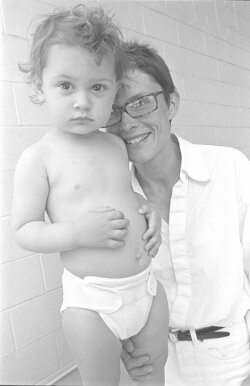Diaper dilemma
Cloth or disposable diapers? The vast majority of parents choose the latter for their convenience and for what is generally perceived as a lower “yuck factor.”
But would parents dismiss cloth diapers so quickly if it turned out disposables could put little boys at risk for testicular cancer or decreased fertility as adults?
Ivana Kadija, a former Manhattan ad exec who’s the new owner of The Stork, Central Virginia’s only diaper delivery service, hopes to deliver that warning to Charlottesvillians and win new business in the process.
Her message may already be soaking in with some families. In the month since she purchased The Stork, she says she's increased the customer base by 50 percent, going from 12 families to 18.
But what supports her claims? Research published in such publications as Discover, Mothering, and online at WebMD.com over the past three years has suggested the cancer and reduced fertility risks, as well as the risk of childhood asthma caused by the chemicals in the high-absorbency diapers made by companies such as Procter & Gamble (Pampers), and Kimberly-Clark (Huggies). Kadija says those studies, coupled with cloth diapers’ perceived benefits for the environment, made cloth an obvious choice for her and her husband, freelance writer Brian Wimer, to use on their own two-year-old daughter, Luka.
But are cloth diapers really environmentally superior? A study by the Arthur D. Little International Management and Technology Consulting Firm in Cambridge, Massachusetts, suggests that while disposable diapers generate more solid waste, reusable diapers generate more process solid waste, i.e. wastewater treatment sludge and incinerator ash. In addition, the study says, reusable diapers consume more water and release higher levels of total water pollutants.
But Kadija counters that disposables use at least as much water during production.
And, she adds, “the water issue pales in comparison with waste management issues, human feces and viruses in landfills issues, energy consumption issues, and infant health issues.”
Not surprisingly, the disposable diaper companies trash Kadija’s assessment.
“Disposable diapers are one of the most thoroughly evaluated and tested products in the world,” says Lisa Jester, spokesperson for Procter & Gamble. Jester says that none of the health claims have ever been accepted by the wider scientific and medical community; she adds that many of the environmental claims against disposable diapers relate to antiquated diapers.
“We use 40 percent less material than 15 years ago,” Jester says. That translates to less waste, and since disposable diapers are more absorbent, and there are fewer leaks, that means less laundering of bedding and clothes, a further saving in water, she says.
“There’s nothing we’ve been taught as physicians to suggest a long-term health risk from disposable diapers,” says local pediatrician Carlos Armengol.
The studies cited by Kadija, he says, are reported in reputable journals, but don’t offer conclusive evidence– just the need for more research. And he offers a different study that finds higher testicular cancer rates in men who wore cloth diapers as babies. The conclusion? More research is needed.
Although Armengol believes “it’s clear” that cloth diapers are better for the environment and that they also may reduce the likelihood of diaper rash, he doesn’t fault “the overwhelming majority” of parents in his practice who use disposables for their convenience– and he won’t try to deter them.
And it’s convenience, the disposable companies say, that keeps today’s busy parents buying disposables. For example, if a child soils a cloth diaper while on a summer outing, the parents must then lug the hot, fetid mass with them until they get home to their diaper pail. A disposable simply requires a trash can.
But although Kadija acknowledges that using cloth requires some advance planning– such as bringing plastic bags along on trips– she insists that doing what’s good for your child and for the environment doesn’t have to mean a big, smelly mess. Kadija says people who imagine saggy, soggy, leaky diapers fastened with sharp pins should take another look.
“There’s a new way of doing cloth diapers,” she says. Instead of the huge safety pins of yore, today’s cloth diapers are attached one of two ways: with Y-shaped rubber clips that hook onto the diaper to keep it secure, or by a waterproof diaper cover that attaches with Velcro and helps retain moisture.
As for the most odious task associated with cloth diapers– ye olde scraping– Kadija says it’s no longer necessary. The Stork’s laundering service, National Linen Company in Roanoke, takes care of all waste disposal and returns the clean diapers to Kadija each week.
For local parents who decide to give cloth diapering a go, Kadija says she delivers and picks up once a week in her 1987 “electrician-style” Chevy Astro (which will soon be fitted with a divider to keep Kadija breathing fresh air). Although the delivery service is limited to a two-mile radius of Charlottesville, Kadija says there is a drop-box on each side of town for those who live outside the radius.
Newborns generally use 70-80 diapers per week, with the number decreasing as the child grows (and goes) less frequently. And with an average cost of $16-$18 per week for delivery and pick-up– plus a $50 refundable deposit– the cost of cloth diapers is approximately the same as disposables, roughly 32 cents each, Kadija says.
The one thing Kadija, the diaper companies, and most pediatricians agree on? It all trickles down to a personal choice. And fortunately, says Procter & Gamble’s Jester, “There is plenty of room for all kinds of products in the marketplace.”
